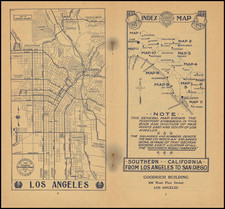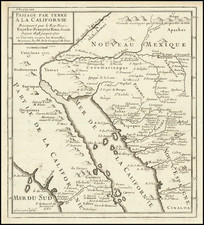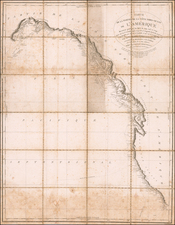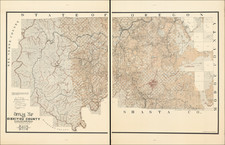Scarce map of California & Nevada, featuring the details of the route of the Virginia and Truckee Railroad.
The map illustrates both the original Virginia & Truckee Railroad line, the Carson & Colorado Railroad (which reached the boom mining region around Keeler, California) and the Virginia & Truckee Railroad's new Tonopah Branch from Bode to Tonopah Butler Post Office, which is illustrated in dashed lines. While the map is dated June, 1904, a note on the verso of on one of the folded panels (illusrated to the right of the map) states "C.N.R.R.H.S. Excursion Oct. 5, 1947." In all other respects, this map appears to be published in or about 1904, but it is possible that this is a commemorative of some sort and we have priced the map on the assumption that it was printed in 1947. If the map is indeed from 1904, it would be one of the earliest printed depictions of the proposed Tonopah / Butler Post Office extension of the line, which was not completed until the second part of 1905.
The Virginia & Truckee Railroad was organized in 1868. At its peak, it connected Reno with Carson City, Virginia City, and Minden. Operating for 80 years, the V&T was Nevada's Bonanza Railroad as it hauled valuable Comstock ore to quartz reduction mills located at Silver City and along the Carson River.
The Virginia & Truckee Railroad Company was organized in Nevada on March 5, 1868. The Railroad was built to connect Nevada's Comstock ore producing mines with quartz reduction mills and, on the return trip, to bring in needed lumber, mining timbers and cord wood for fuel. Surveyed by local surveyor Isaac E. James, the 21-mile standard gauge line was completed on January 29, 1870 between Carson and Virginia City. A 31-mile extension north from Carson City through Franktown, Washoe City, and Steamboat Springs connected the Comstock with transcontinental rail service at Reno in August of 1872.
The V&T was owned by William Ralston, Darius O. Mills and William Sharon on behalf of the Union Mill & Mining Company and the Bank of California. The completion of the V&T permitted the further development of Comstock mines by allowing the economical reduction of lower grade ores through reduced freight rates to the mills and by increasing the essential supply of lumber, mining timbers, and cord wood for fuel. It also allowed for up-scale passenger service to Carson and Virginia City was a by-product of the short line's connection with transcontinental rails at Reno.
For nearly twenty years the V&T was a major political and economic factor in the growth and development of Western Nevada and Eastern California. During the late 1870s, The 300-mile Carson & Colorado Railroad (also illustrated on this map) was built from Mound House, Nevada, to Keeler, California, and was operated by principals of the V&T from 1880 to 1900. V&T dividends funded the establishment of Hawthorne, Nevada, the Hawthorne Water Works, lumbering operations at Lake Tahoe and Southern Nevada, the Columbus Wagon Road to Bodie, a large soda plant at Keeler, and dozens of mining ventures at Aurora, Bodie, Hawthorne, Candelaria, Belleville, Columbus, and Cerro Gordo.
With revenues derived from the twentieth century Tonopah boom, a new Virginia & Truckee Railway Company was incorporated in Nevada on June 24, 1905 to purchase the predecessor company and to construct a 15-mile branch south from Carson City to Minden (curiously, this branch is not illustrated on the map). This branch offered transportation facilities to a growing agricultural and grazing district and resulted in substantial new revenue to the railway until such time as a surface highway was constructed between Reno, Carson City, and Minden in the years 1921-1922. Known today as U.S. Highway 395, the concrete highway completely paralleled the V&T between Reno and Minden and ultimately was the cause of the railway's red ink operations beginning in 1923. Prior to that time, the V&T was the only efficient means of transportation for freight and passengers between these communities.
After 80 years of continuous operation, the Virginia & Truckee finally succumbed to the increasing competition of highway truck traffic. The Bonanza short line's last official revenue train operated on May 31, 1950 between Reno, Carson City, and Minden. Following the local sale of the railway's structures and properties, the rails between Reno and Minden were finally removed and the famous V&T became but a legend.
Beebe, Lucius and Charles Clegg. Virginia & Truckee: A Story of Virginia City and Comstock Times. Carson City, Nevada: Nevada State Railroad Museum, 1991.Wurm, Ted. Rebirth of the Virginia & Truckee R.









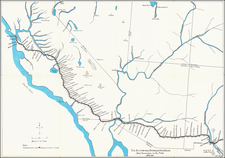
![[ Coronado Beach Broadsheet ] Map of Coronado Beach San Diego, California / Coronado Beach and Surrounding Country](https://storage.googleapis.com/raremaps/img/small/99912.jpg)
